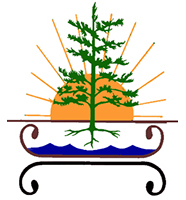
Abenaki Traditions
What We Ate
There was a division of labor based on a philosophy of life, a religious belief. The men hunted for wild game and gathered fish. The women worked in the fields.
The women picked all types of berries and nuts. They gathered lilly roots, wild rice, onions, chives, wild garlic, mushrooms, mint, swamp cabbage among many of the wild plants. They gathered herbs for medicines and garnishes, such as yarrow, burdock, foxglove, catnip, licorice among a wide variety of other herbs.
They planted the main crops of corn, they used a method called "Companion Farming": the three sister crops were planted together on a big mound. The corn grew upwards and provided natural poles for the beans. The squash or pumpkins spread all around the base of the mound providing a cover to keep in the moisture.All three were harvested at the same time. They were also dried to be used during the winter.
The women raised other crops: snow peas, cucumbers and gourds.
The men hunted and trapped wild game, such as moose, deer, rabbit, and turkey both for food and clothing.
They fished in fresh water and salt water.
The Indians had a varied menu: venison, wild turkey, salmon, trout, clam chowder, corn-on-the-cob, corn bread, corn fritters, squash, succatsh, mushroom and turtle soups and maple candy lollipops were some the foods that they enjoyed.
Whenever the hunter or fisherman returned from a succesful expedition, his children were sent forth to distribute the catch to people in the village. The bounty was shared by all. The hunter kept only a basic supply for his family.
Games
The Indian Yo-yo was "catch the hoop". Shinny was an early form of baseball. The objective of "snow snakes" was to slide a stick down a snow trough and have it slide farther than oneone else's stick. In "hen & chicks", the fox tried to pull the chicks off the the hen. The game of lacrosse was invented by the Indians.
Adults played games of "cards" and "dice". A favorite was the "plum stone" game: five decorated and painted plum stones were tossed from a wooden bowl; certain combinations of moon and star designs with black and white counted for points.
The Courting Flute
In order to identify himself to all the villages, the young man would make a special flute. After dark, he would play this flute outside the lodge of a girl in whom he was interesed. If she were interested in him, she would slip outside to meet him.
If she was not interested, she would pretend that she hadn't heard him. The young man was thence saved from a possible face-to-face rejection.
Traditional Practices- Colors, Clothing
We often get questions about traditional clothing, tribal colors, and ways. There are many sources of information on this subject. Unfortunately, they do not always agreed.
Some recent reference books are available which bring some of this into better focus. It should be noted that most traditional clothing and ways were subject to the location.
Some very clear differences are believed to exist between Eastern, Central, and Western Abenaki. The time period and amount of colonial contact was also a key factor.
In specific to the Cowasuck, we have identified a contemporary symbol and color pattern that we are comfortable with.
A Pine Tree in green, comprised of thirteen branches, six on each side with a top branch. These branches project in an upward angled direction from the center.
The tree has three white roots that are equally spaced in a downward direction. The addition of a rising sun, water, snow, and earth are acceptable as well as "Wabanki curl" designs.
The color scheme is: Green for the White Pines; Yellow, Red, or Orange for the Raising Sun; White for the snows of the north; Blue for the ocean, lakes, and rivers over which the Sun rises; Brown for Mother Earth - the shore lines, and White or Black background is acceptable for all uses.